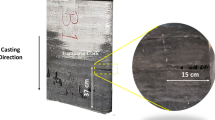Abstract
Microstructure evolution of commercial pure titanium is investigated by interrupted in situ electron backscatter diffraction (EBSD) measurement during tensile deformation along transverse direction at room temperature. After 24 pct elongation, the split basal texture of initial material is weakened and rotated around 90 deg along normal direction (ND). \({{11}\bar{2}{{2}}}\)-\({{10}\bar{1}{{2}}}\) double twin is the main reason for the change of texture. The basal poles are rotated nearly perpendicular to ND by the primary \({{11}\bar{2}{{2}}}\) twin and back to ND through the reorientation of \({{10}\bar{1}{{2}}}\) secondary twin. Both Schmid factor criterion and displacement gradient accommodation are considered to predict the twin-induced texture evolution during TD tension. Kink bands formed by the accumulation of basal 〈a〉 dislocations are also observed in the deformed grain. The activation of other slip systems can deviate the rotation axis and reduce the rotation angle of kink boundary. Besides, the kink boundary with high basal dislocation density obviously hinders the twin transmission and simultaneously can be taken as a preferential nucleation site for \({{11}\bar{2}{{2}}}\) twin.












Similar content being viewed by others
References
M. Ishiki, T. Kuwabara, Y. Hayashida, Int. J. Mater. Form. 4, 193–204 (2011)
Z. Zeng, Y. Zhang, S. Jonsson, Mater. Des. 30, 3105–3111 (2009)
Y.B. Chun, S.H. Yu, S.L. Semiatin, S.K. Hwang, Mater. Sci. Eng. A 398, 209–219 (2005)
N.P. Gurao, R. Kapoor, S. Suwas, Acta Mater. 59, 3431–3446 (2011)
M. Battaini, E.V. Pereloma, C.H.J. Davies, Metall. Mater. Trans. A 38A, 276–285 (2007)
S. Panda, S.K. Sahoo, A. Dash, M. Bagwan, G. Kumar, S.C. Mishra, S. Suwas, Mater. Charact. 98, 93–101 (2014)
X. Huang, K. Suzuki, Y. Chino, Scripta Mater. 63, 473–476 (2010)
M.H. Yoo, Metall. Trans. A 12, 409–418 (1981)
Y. Ren, X. Zhang, T. Xia, Q. Sun, Q. Liu, Mater. Des. 126, 123–134 (2017)
J.W. Won, D. Kim, S.G. Hong, C.S. Lee, J. Alloys Compd. 683, 92–99 (2016)
S. Wang, C. Schuman, L. Bao, J.S. Lecomte, Y. Zhang, J.M. Raulot, M.J. Philippe, X. Zhao, C. Esling, Acta Mater. 60, 3912–3919 (2012)
S. Xu, M. Gong, Y. Jiang, C. Schuman, J.S. Lecomte, J. Wang, Acta Mater. 152, 58–76 (2018)
J.B. Hess, C.S. Barrett, JOM 1, 599–606 (1949)
K. Hagihara, T. Mayama, M. Honnami, M. Yamasaki, H. Izuno, T. Okamoto, T. Ohashi, T. Nakano, Y. Kawamura, Int. J. Plast. 77, 174–191 (2016)
T. Matsumoto, M. Yamasaki, K. Hagihara, Y. Kawamura, Acta Mater. 151, 112–124 (2018)
S. Yamasaki, T. Tokuzumi, W. Li, M. Mitsuhara, K. Hagihara, T. Fujii, and H. Nakashima: Acta Mater.
S. Jin, K. Marthinsen, Y. Li, Acta Mater. 120, 403–414 (2016)
M. Yamasaki, K. Hagihara, S.I. Inoue, J.P. Hadorn, Y. Kawamura, Acta Mater. 61, 2065–2076 (2013)
N.J. Lane, S.I. Simak, A.S. Mikhaylushkin, I.A. Abrikosov, L. Hultman, M.W. Barsoum, Phys. Rev. B 84, 184101 (2011)
Y. Zheng, W. Zeng, Y. Wang, S. Zhang, Mater. Sci. Eng. A 702, 218–224 (2017)
S. Wronski, M. Jedrychowski, J. Tarasiuk, B. Bacroix, Mater. Sci. Eng. A 692, 113–126 (2017)
S. Wang, Y. Zhang, C. Schuman, J.S. Lecomte, X. Zhao, L. Zuo, M.J. Philippe, C. Esling, Acta Mater. 82, 424–436 (2015)
B. Beausir and J.-J. Fundenberger, Analysis Tools for Electron and X-Ray Diffraction (Université de Lorraine - Metz, ATEX - Software, 2017).
W. Pantleon, Scripta Mater. 58, 994–997 (2008)
É. Martin, L. Capolungo, L. Jiang, J.J. Jonas, Acta Mater. 58, 3970–3983 (2010)
Y.B. Chun, M. Battaini, C.H.J. Davies, S.K. Hwang, Metall. Mater. Trans. A 41A, 3473–3487 (2010)
S. Xu, L.S. Toth, C. Schuman, J.-S. Lecomte, M.R. Barnett, Acta Mater. 124, 59–70 (2017)
T. Hama, A. Kobuki, H. Takuda, Int. J. Plast. 91, 77–108 (2017)
J.J. Jonas, S. Mu, T. Al-Samman, G. Gottstein, L. Jiang, Ė Martin, Acta Mater. 59, 2046–2056 (2011)
S. Xu, M. Gong, C. Schuman, J.-S. Lecomte, X. Xie, J. Wang, Acta Mater. 132, 57–68 (2017)
A. Ghaderi, M.R. Barnett, Acta Mater. 59, 7824–7839 (2011)
Acknowledgments
The first author Qian Wang is grateful to the China Scholarship Council for the support of her PhD study in France.
Author information
Authors and Affiliations
Corresponding authors
Additional information
Publisher's Note
Springer Nature remains neutral with regard to jurisdictional claims in published maps and institutional affiliations.
Manuscript submitted October 28, 2020; accepted March 5, 2021.
Appendix
Appendix
To investigate the accommodation mechanism, the displacement gradient tensor of twinning \({{D}}^{t}\) is always transformed into other coordinate system, such as crystal system, sample system, or another twinning system. First, we need to build the coordinate rotation matrix from twinning system to crystal system.
where n, m, and p represent the twinning shear direction (n), normal of twin habit plane (m), and normal of shear plane (p). The coordinate rotation matrix sample system to crystal system is as follows:
where φ1, Φ, and φ2 are Euler angles from HKL system. The displacement gradient tensor of Twin 1 (\({{D}}^{{t1}}\)) is transformed from Twin 1 frame (\({\mathbf{D}}_{{t1}}^{{t1}}\)) to crystal frame of Grain 1 (\({\mathbf{D}}_{{g1}}^{{t1}}\)) as follows:
The transformation of \({{D}}^{{t1}}\) from Grain 1 frame (\({\mathbf{D}}_{{{g}}{1}}^{{t1}}\)) to sample frame (\({\mathbf{D}}_{{s}}^{{t1}}\)) to Grain 2 frame (\({\mathbf{D}}_{{g2}}^{{t1}}\)) is:
The transformation of \({{D}}^{{t1}}\) from Grain 2 frame (\({\mathbf{D}}_{{g2}}^{{t1}}\)) to the frame (\({\mathbf{D}}_{{t2}}^{{t1}}\)) of Twin 2 in Grain 2 is:
Rights and permissions
About this article
Cite this article
Wang, Q., Wang, S., Moll, P. et al. Microstructure Evolution of Commercial Pure Titanium During Interrupted In Situ Tensile Test. Metall Mater Trans A 52, 2477–2488 (2021). https://doi.org/10.1007/s11661-021-06237-1
Received:
Accepted:
Published:
Issue Date:
DOI: https://doi.org/10.1007/s11661-021-06237-1




